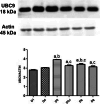Dynamic changes in sumoylation related proteins SUMO1, SENP1, and UBC9 during the peri implantation period in mice
- PMID: 40593246
- PMCID: PMC12218327
- DOI: 10.1038/s41598-025-07677-0
Dynamic changes in sumoylation related proteins SUMO1, SENP1, and UBC9 during the peri implantation period in mice
Abstract
The healthy progression and termination of pregnancy depend critically upon embryo development, acquisition of uterine receptivity, implantation, and decidualization during the peri-implantation period. Sumoylation is a post-translational modification that affects the stability, transcriptional activity, and cellular localization of proteins. In our study, we investigated the localization and expression of SUMO1 (small ubiquitin-like modifier), SENP1 (sentrin-specific protease 1), and UBC9 (SUMO-conjugated enzyme UBC9), members of the sumoylation mechanism, in the mouse uterus and implantation sites during the peri-implantation period. Localization and expressions of SUMO1, SENP1, and UBC9 were determined by immunohistochemistry and Western blot, respectively. Estrogen (E2) and progesterone (P4) levels were measured by ELISA. SUMO1 was at the highest level in the luminal and gland epithelium and stroma on the 5th day of pregnancy compared to other pregnancy days. SENP1 was high on the 4th but low on the 5th day of pregnancy. On the 6th and 8th days of pregnancy, expressions of SUMO1 and SENP1 were decreased, while the amount of UBC9 was similar to other days of pregnancy. According to ELISA, E2 reached its highest level on the 4th day of pregnancy, and P4 reached its highest level on the 8th day of pregnancy. SUMO1, SENP1, and UBC9 are expressed at different levels in the uterus and implantation sites during early pregnancy. Our findings suggest that the sumoylation mechanism may play a role in the implantation and decidualization processes of mice.
Keywords: Mouse; SENP1; SUMO1; UBC9; Uterus.
© 2025. The Author(s).
Conflict of interest statement
Declarations. Competing interests: The authors declare no competing interests. Ethical approval: All applicable international, national, and/or institutional guidelines for the care and use of animals were followed. The experimental protocol was approved by the Animal Care and Use Committee of Akdeniz University Faculty of Medicine (approval number: 1264/2021.02.018).
Figures









Similar articles
-
UBC9-Mediated SUMO Pathway Drives Prohibitin-1 Nuclear Accumulation and PITX1 Repression in Primary Osteoarthritis.Int J Mol Sci. 2025 Jun 29;26(13):6281. doi: 10.3390/ijms26136281. Int J Mol Sci. 2025. PMID: 40650059 Free PMC article.
-
SUMOylation Negatively Regulates Angiogenesis by Targeting Endothelial NOTCH Signaling.Circ Res. 2017 Sep 1;121(6):636-649. doi: 10.1161/CIRCRESAHA.117.310696. Epub 2017 Jul 31. Circ Res. 2017. PMID: 28760777 Free PMC article.
-
Crosstalk between SUMOylation and ubiquitination controls the stability of transcription factor zinc finger protein 24: a novel antitumor mechanism in bladder cancer.Oncogene. 2025 Aug;44(31):2762-2777. doi: 10.1038/s41388-025-03450-9. Epub 2025 May 28. Oncogene. 2025. PMID: 40437183
-
Oxytocin antagonists for assisted reproduction.Cochrane Database Syst Rev. 2021 Sep 1;9(9):CD012375. doi: 10.1002/14651858.CD012375.pub2. Cochrane Database Syst Rev. 2021. PMID: 34467530 Free PMC article.
-
Peri-implantation glucocorticoid administration for assisted reproductive technology cycles.Cochrane Database Syst Rev. 2022 Jun 30;6(6):CD005996. doi: 10.1002/14651858.CD005996.pub4. Cochrane Database Syst Rev. 2022. PMID: 35771604 Free PMC article.
References
MeSH terms
Substances
LinkOut - more resources
Full Text Sources
Miscellaneous

